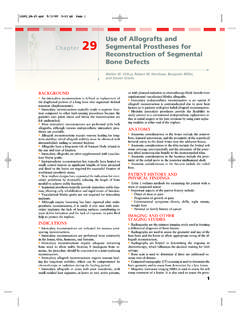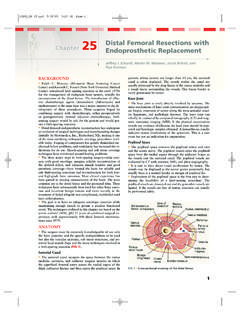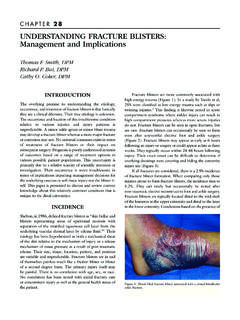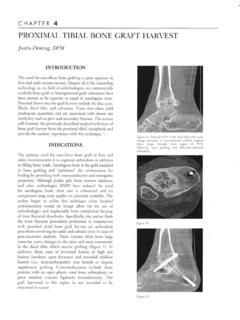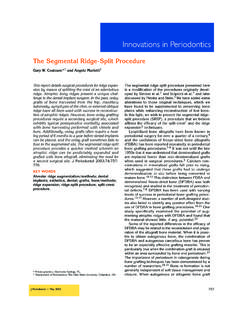Transcription of 11 Treatment of Metastatic Bone Disease - …
1 11 Treatment of Metastatic BoneDiseaseMartin MalawerOVERVIEWFew skeletal metastases require surgical intervention. Radiotherapy, chemotherapy or both often provide sympto-matic relief. An impending or actual pathologic fracture requires operative fixation because fractures through atumor-bearing bone rarely heal without such goals of fixation are to relieve pain, improve function and ambulation, facilitate medical and nursing care,and improve psychological well-being (Figures and ). The primary functional goal of surgical interventionis to allow immediate weight-bearing. Surgery should be avoided if this cannot be achieved. A variety of tech-niques, including prosthetic reconstruction (especially about the hip) or a combination of internal fixationcombined with polymethyl methacrylate (PMMA), provides immediate fixation and stability.
2 After the wound hashealed, radiotherapy is usually used to arrest local tumor growth, permit bony repair, and prevent re-growth oftumor around the fixation device. This chapter discusses the techniques of Treatment of long bone Chapter 11 21/02/2001 15:30 Page 215 INTRODUCTIONThe role of the orthopedic surgeon in the managementof skeletal metastases is to: (1) confirm the diagnosis; (2)treat pathologic fractures; and (3) monitor patients atrisk for pathologic fracture. Surgery can play animportant role in reducing pain, improving function,and increasing quality of life, even in patients with veryshort life expectancies. Additionally, aggressive treat-ment of solitary skeletal metastases may improve long-term survival in selected patients. For example, patientswith renal cell cancer and a solitary skeletal metastasisamenable to wide resection can achieve a 30 35% 5-year survival.
3 All cancer patients with new onset of pain must beassumed to have a skeletal metastasis until provenotherwise. The initial evaluation of such a patient,however, must not rule out the possibility that thelesion is unrelated to the cancer. In approximately 45%of cases a solitary hot spot seen on a bone scan in acancer patient otherwise free of Disease is associatedwith an unrelated process. Needle biopsy has beenshown to be effective in diagnosing skeletal metastasesin patients with a history of cancer. Most patients,however, present with multiple skeletal lesions, makingthe diagnosis of Metastatic Disease certain. With few exceptions, patients who present with apainful pathologic fracture are candidates for surgicalintervention.
4 Management must be tailored to theindividual; this entails balancing the benefit of surgeryMusculoskeletal Cancer Surgery216 Figure bone scan showing multiple hotspots involving the ribs and shoulder girdle. Thisdemonstrates the typical spread of carcinoma to the skeletalsystem. Figure photograph showing several typesof proximal femoral replacements used to reconstruct largeskeletal defects following the resection of Metastatic tumorsof the proximal femur. The prosthesis (arrow), is a customprosthesis to replace approximately one-half of the other two prostheses are modular prostheses that arealso utilized in the Treatment of primary bony sarcomas. Themajor indications for segmental replacement of the proximalfemur are large, destructive, lytic lesions involving the head,neck, and shaft; solitary metastases; and recurrent tumorfollowing previous attempts at intramedullary fixation withor without Chapter 11 21/02/2001 15:30 Page 216and the risks associated with operating on a patientwith a limited life expectancy and who is in poormedical condition.
5 Isolated fractures of non-weight-bearing bones in the upper extremities can frequentlybe managed with palliative radiotherapy and casting orbracing. A patient with lower-extremity lesions requiresgreater use of the upper extremities for transfers andcrutch or walker-assisted ambulation. Under thesecircumstances surgical intervention is often extremities must be carefully examined beforeembarking on a course of Treatment . The goals of surgical fixation are to relieve pain,improve function and ambulation, facilitate medical andnursing care, and improve psychological requires a different approach from that used fornon-neoplastic lesions. Immediate fixation must beobtained at the time of surgery: these patients rarelytolerate multiple surgical procedures.
6 Bony union almostnever occurs without surgery and radiotherapeutictreatment. The basic principle of surgical managementis internal fixation or prosthetic replacement combinedwith PMMA. Cementation permits immediate stabilityand early mobilization and pain PATHOLOGIC FRACTURESAny skeletal lesion may cause a pathologic for selecting patients for prophylactic fixationhave slowly evolved. Early criteria were based solely onretrospective observations of pathologic fractures in theproximal femur and hip. This was of great importanceto orthopedists because of the technological difficultyin fixing such fractures, as well as the high mortalityrates associated with hip fractures (Figures and ).The first set of combined guidelines (1986) forprophylactic fixation of proximal femur were:1(1)greater than 50% cortical destruction seen on CT, (2) alytic lesion of the proximal femur > in diameter,and (3) avulsion of the lesser trochanter.
7 While theseguidelines were helpful for lytic lesions of the femur,they failed to account for other patterns of mixed orpermeative lesions and would not be readily applied toother sites. In addition, these guidelines failed toaccount for lesions amenable to nonsurgical , effective adjuvant treatments haveresulted in improved patient survival, increasing thetime at risk for any given lesion to fracture. Therefore, Treatment of Metastatic bone Disease217 ABFigure (see above and following page).Malawer Chapter 11 21/02/2001 15:30 Page 217 Thompson2revised the Harrington1criteria defined asfollows: (1) large lytic lesions occupying 50% or more ofthe cortical diameter unless protected until reconsti-tuted with radiation therapy, medical management, orboth; and (2) all destructive lesions of the femoral neckin patients with a survival estimate of >3 months.
8 PREOPERATIVE EVALUATION ANDINTERVENTIONSS pecial preoperative considerations are needed becausethese patients often have extensive metabolic, hema-tologic, and nutritional deficiencies. The risk ofinfection is increased because of possible multiplesources of sepsis ( colostomy, urinary tract infection),neutropenia from chemotherapy or other adjuvantmodalities, generalized nutritional deficits, and poorlocal skin condition from prior radiotherapy or otherprocedures. Perioperative antibiotics are recommendedfor all patients. All patients should have hematologicand clotting evaluation, because many may suffer fromanemia of chronic Disease or depletion of clotting factorsbecause of a vitamin K deficiency or tumor involve-ment of the liver.
9 Adequate blood replacement shouldbe available because curettage of many carcinomas especially myeloma, thyroid tumor, and renal cellcarcinoma often leads to substantial blood loss. Thecombination of pre-existing anemia and expected bloodloss mandates the use of preoperative bloodtransfusions. Thrombocytopenia occasionally occursintraoperatively and should be treated aggressivelywhen it occurs. Disseminated intravascular coagulation(DIC) has been noted. As many of these patients are older, coexistingdiseases ( hypertension, diabetes, renal insufficiency,peripheral vascular Disease , and cardiopulmonarydisease) must be identified and controlled. Thepresence of other sites of skeletal Disease may requirespecial precautions at the time of surgery to preventadditional pathologic fractures.
10 Rib involvement,common in advanced multiple myeloma, may makerespiration difficult, leading to prolonged or permanentventilator dependence following general disorders associated with skeletal metastasesMusculoskeletal Cancer Surgery218 Figure (A) Plain radiographs of the fixation of amultiple myeloma of the lesser trochanteric region of theproximal femur which has progressed despite radiationtherapy and fractured with a plate and screws in place. (B)Postoperative radiograph following resection of theproximal Chapter 11 21/02/2001 15:31 Page 218must also be controlled. Of particular concern ishypercalcemia, which can lead to sudden death duringanesthesia. The use of bisphosphonates, includingpamidronate, have been shown to be effective in reduc-ing the serum calcium to normal levels.

